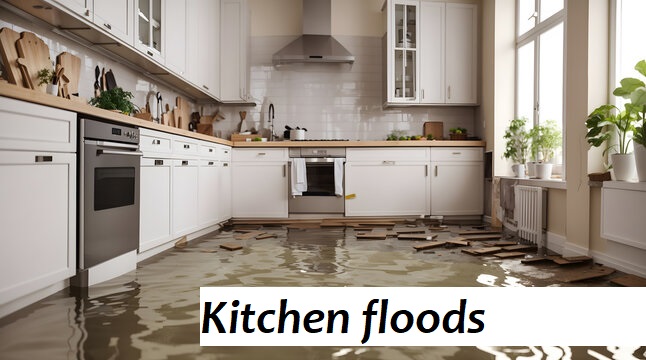A flooded kitchen can be a homeowner’s worst nightmare. Not only is it a huge inconvenience, but if water damage is not dealt with quickly and correctly, it can lead to mold and other serious problems. That’s why knowing what to do if your kitchen ever becomes flooded is essential.
If your kitchen has been flooded, it’s crucial to take action quickly to minimize the damage. Fortunately, there are some steps you can take to clean up a flooded kitchen and get it back to normal. Here are some tips from fronteras mexican restaurant on how to clean up a flooded kitchen and get it back to normal as soon as possible.
What causes a flooded kitchen?
There are a few kitchen appliances that can cause a flood. The most common culprits are dishwashers, refrigerators, and kitchen sinks. If these appliances start to leak, it can quickly lead to a flooded kitchen.
Dishwasher leaks
Dishwasher leaks can release either clean or dirty water into your kitchen. For example, if the pipes leading into the dishwasher rupture or their seals fail, that clean water can seep into the surrounding area. On the other hand, if the dishwasher’s drain line gets clogged, it can cause dirty water to overflow and flood the kitchen.
Refrigerator leaks
Refrigerators can also be a source of kitchen flooding. The water line that supplies the ice maker or water dispenser can develop a leak, causing water to spill out onto the floor. Additionally, if the refrigerator’s defrost drain becomes clogged, it can lead to water buildup and eventually a flood.
Sink and faucet leaks
Kitchen sinks and their associated plumbing are another common culprit of flooded kitchens. A leaky faucet or a clogged sink drain can allow water to back up and overflow, creating a mess in the surrounding area.
Other causes
In some cases, a flooded kitchen can be the result of a larger plumbing issue, such as a burst pipe or a problem with the home’s main water line. Severe weather events, such as heavy rains or floods, can also cause water to enter the kitchen and lead to a flooding situation.
Typical damage we see in a flooded kitchen
When a kitchen is flooded, the extent of the damage can vary greatly depending on the source and duration of the flood. However, there are some common types of damage that water restoration experts often encounter.

Water damage to floors and walls
One of the most obvious signs of a flooded kitchen is water damage to the floors and walls. The water can seep into and saturate the materials, causing them to become swollen, warped, or even start to crumble.
Damage to cabinetry and countertops
Kitchen cabinets and countertops are also susceptible to damage from a flood. The water can cause the wood or laminate to swell, warp, or delaminate. In severe cases, the cabinets may need to be completely replaced.
Electrical and appliance damage
A flooded kitchen can also wreak havoc on the electrical system and any appliances that were submerged in water. Outlets, switches, and wiring can become damaged, posing a serious safety hazard. Appliances like dishwashers, refrigerators, and ovens may also need to be replaced if they were exposed to the flood waters.
Mold and mildew growth
One of the most concerning problems that can arise from a flooded kitchen is the growth of mold and mildew. If the water damage is not addressed quickly and thoroughly, these fungi can start to proliferate, which can be a health hazard for the homeowners.
Structural damage
In extreme cases, a flooded kitchen can even cause structural damage to the home. If the water seeps into the walls or foundation, it can compromise the building’s integrity and lead to costly repairs.
What to do if your kitchen floods in 6 steps
If your kitchen has been flooded, it’s crucial to act quickly to minimize the damage. Here are the six steps you should take:
1. Turn off the water supply
The first thing you should do is locate the main water shut-off valve and turn off the water supply to the kitchen. This will stop the flow of water and prevent the flood from getting worse.
2. Unplug and remove electrical appliances
Next, unplug any electrical appliances that may have been affected by the flood, such as the dishwasher, refrigerator, or oven. If possible, move these appliances to a dry location to prevent further damage.
3. Remove standing water
Use mops, towels, and a wet/dry vacuum to remove as much standing water as possible from the kitchen floor and surrounding areas. This will help prevent the water from seeping deeper into the structure and causing more extensive damage.
4. Dry out the area
Once the standing water has been removed, use fans, dehumidifiers, and open windows to help dry out the kitchen thoroughly. This will help prevent the growth of mold and mildew.
5. Assess the damage
Carefully inspect the kitchen for any damage to the floors, walls, cabinets, or appliances. Take note of any areas that appear to be water-damaged or compromised.
6. Contact a water damage restoration professional
Finally, it’s important to call in a professional water damage restoration company to assess the full extent of the damage and develop a comprehensive plan for cleaning and restoring your kitchen. These experts have the knowledge, equipment, and expertise to properly address all aspects of the flood damage and ensure that the kitchen is restored to a safe and functional condition.
How we clean up a flooded kitchen
When a water damage restoration professional is called in to clean up a flooded kitchen, they will follow a specific process to ensure that the area is properly dried, disinfected, and restored.
Assess the extent of the damage
The first step is to thoroughly assess the extent of the water damage in the kitchen. This involves inspecting the floors, walls, cabinets, and appliances to identify all affected areas.
Remove standing water
Next, the restoration team will use specialized equipment, such as powerful wet/dry vacuums and pumps, to remove any standing water from the kitchen. This helps prevent the water from seeping deeper into the structure and causing more extensive damage.
Dry out the kitchen
Once the standing water has been removed, the restoration team will use high-powered fans, dehumidifiers, and other drying equipment to thoroughly dry out the kitchen. This may take several days, depending on the severity of the flood.
Clean and disinfect
After the kitchen is fully dried, the restoration team will clean and disinfect all affected surfaces. This involves using EPA-approved antimicrobial solutions to kill any mold, bacteria, or other contaminants that may have been present.
Replace damaged materials
If any of the kitchen’s materials, such as the flooring, walls, or cabinetry, have been too severely damaged to be salvaged, the restoration team will replace them. This ensures that the kitchen is restored to a safe and functional condition.
Restore the kitchen
Finally, the restoration team will work to restore the kitchen to its pre-flood condition. This may involve reinstalling appliances, repairing or replacing cabinetry, and ensuring that all electrical and plumbing systems are functioning properly.
Throughout the entire process, the restoration team will work closely with the homeowner to ensure that the kitchen is restored to their satisfaction and that any necessary repairs or replacements are completed in a timely and efficient manner.
What about mold?
One of the most significant concerns when dealing with a flooded kitchen is the potential for mold growth. Mold can start to develop within 24-48 hours of the initial flood, and if left unchecked, it can spread quickly and pose serious health risks to the occupants of the home.
Identifying mold
It’s important to be on the lookout for any signs of mold growth in the kitchen following a flood. This can include visible mold patches, a musty odor, or discoloration on walls, floors, or other surfaces.
Preventing mold growth
To prevent mold growth, it’s crucial to act quickly to dry out the kitchen and remove any standing water. The restoration team will use specialized drying equipment and techniques to ensure that the kitchen is thoroughly dried and that any moisture-holding materials, such as drywall or insulation, are replaced.
Mold remediation
If mold is discovered, the restoration team will follow established protocols for mold remediation. This may involve the use of EPA-approved antimicrobial solutions, the removal and replacement of affected materials, and the implementation of air filtration systems to capture and remove airborne mold spores.
Ongoing mold prevention
Once the mold has been addressed, the restoration team will also provide guidance on how to prevent future mold growth in the kitchen. This may include recommendations for improving ventilation, addressing any ongoing moisture issues, and regularly inspecting the kitchen for signs of mold.
By addressing mold concerns promptly and effectively, the restoration team can help ensure that the kitchen is restored to a safe and healthy condition for the homeowners.
Revere Construction & Roofing can help with your flooded kitchen!
If your kitchen has been flooded, it’s important to act quickly to minimize the damage and prevent further issues, such as mold growth. At Revere Construction & Roofing, our team of water damage restoration experts has the knowledge and experience to handle all aspects of a flooded kitchen recovery.
We understand the stress and inconvenience that a flooded kitchen can cause, which is why we work quickly and efficiently to get your kitchen back to its pre-flood condition. Our process involves a thorough assessment of the damage, the removal of standing water, the drying and dehumidification of the affected areas, and the restoration of any damaged materials or appliances.
In addition to our water damage restoration services, we also offer a wide range of other construction and roofing services to help you maintain and improve your home. Whether you need a roof replacement, kitchen remodeling, or any other type of home improvement project, our team of skilled professionals is here to help.
Don’t let a flooded kitchen ruin your life. Contact Revere Construction & Roofing today to schedule a consultation and learn more about how we can help you recover from this unexpected disaster.
Conclusion
A flooded kitchen can be a stressful and overwhelming experience, but with the right knowledge and the help of a professional water damage restoration team, you can get your kitchen back to normal in no time. By following the steps outlined in this article, you can minimize the damage, prevent the growth of mold and mildew, and restore your kitchen to a safe and functional condition.
At Revere Construction & Roofing, we are committed to helping our clients recover from all types of water damage, including flooded kitchens. Our team of experts has the skills and equipment necessary to quickly and effectively address the problem, ensuring that your kitchen is restored to its pre-flood condition as soon as possible.
If you’ve experienced a flooded kitchen, don’t hesitate to reach out to us. We’re here to help you every step of the way, from the initial assessment to the final restoration. Contact us today to schedule a consultation and learn more about how we can help you recover from this unexpected disaster.

Related posts: